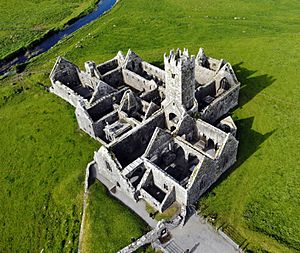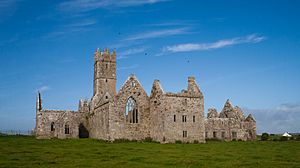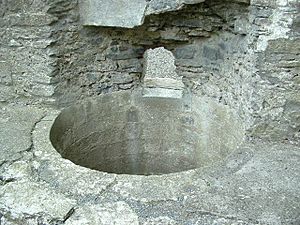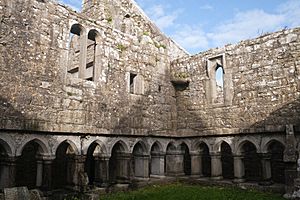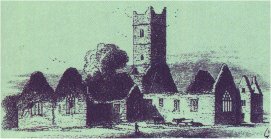Ross Errilly Friary facts for kids
The Ross Errilly Friary is a very old religious building from the Middle Ages (the medieval period). It was home to Franciscan friars, a type of monk. You can find it about a mile northwest of Headford in County Galway, Ireland. It's one of the best-preserved medieval monastic sites in the whole country and is considered a National Monument of Ireland. Even though locals often call it "Ross Abbey," it's actually a friary because the community never had an abbot (a leader of an abbey).
The friary has a church and a bell tower on the south side. In the middle, there's a small but well-kept central cloister, which is an open courtyard. To the north are the buildings where the friars lived and worked. These include a kitchen with an oven and a special water tank for keeping live fish! There was also a bake house and a dining area called a refectory. The sleeping areas, or dormitories, were on the upper floors. One cool thing about Ross Errilly is that it has a second courtyard. This was built because the number of friars living there grew quite a lot.
Like many old Christian sites in Ireland that are no longer used, Ross Errilly is still a place where local people bury their loved ones. You can find tombs from when the friary was active, as well as many graves from the 1700s, 1800s, and 1900s inside the church walls. Sometimes, old tombstones even form parts of the walkways.
Contents
History
How it Started
Historians have different ideas about when Ross Errilly Friary was first built. Some old records say it was founded in 1351. However, looking at the building's style and other old papers, most experts now think it was built a bit later, probably around 1460. The oldest written record we have is from 1469, when a man named John Blake from Galway left some money to the friary in his will.
There's a story that it was founded in 1351 by Archbishop MacHugh, a Franciscan from the Headford area. He died in 1349 during a terrible sickness called the "Black Death." It's possible it took a few years to build the first part of the friary because of the plague and the wet ground. What we do know for sure is that any religious building on the site before the 1400s was made much bigger during the 15th century. Around 1473, some Franciscans from Ross Errilly even traveled to Donegal to help start another friary there. This is where the famous "Four Masters" later wrote their important historical books.
After the English Reformation
Life at Ross Errilly became very difficult after the English Reformation. This was when King Henry VIII of England decided to break away from the Catholic Church in Rome. The Franciscans strongly disagreed with this, and it caused them many problems. In 1538, English authorities put 200 monks in prison, and many others were forced to leave or were killed. For a long time after this, the Franciscans at Ross Errilly faced repeated evictions and other harsh treatments.
When Queen Elizabeth I became queen, the friary was taken by the government and given to Richard Burgh, the Earl of Clanrickarde. But Burgh, whose family had helped found the friary, secretly gave it back to the Franciscans. In 1572, a ditch and wall were built around the friary for protection.
In 1584, the English government took the monastery again and gave it to an English noble. He kicked out the monks and stole things from the building. But in 1586, the Earl of Clanrickarde bought the monastery back and, once again, returned it to the Franciscans. By the end of the century, however, the government had again forced the monks out and turned the monastery into an English army base during the Nine Years' War.
In 1604, Ulick Burke, the 3rd Earl of Clanrickarde, continued his family's tradition of supporting Ross Errilly. He paid to fix up the monastery, and the Franciscans moved back in. But their peace didn't last long. In 1612, Lord Arthur Chichester, a high-ranking English official in Ireland, ordered the Protestant archbishop of Tuam to expel the monks and destroy the altars. The archbishop seemed to follow the order, but he secretly warned the friars beforehand, telling them to move their most valuable items to safety.
In 1626, the monks returned to Ross Errilly and had about 25 years of peace. Records show that at this time, there were only six priests and two brothers living there.
Rebellion and the Cromwellian Era
On February 18, 1642, Ulick Burke and the monks helped rescue about 40 Protestant people who were fleeing from a rebellion. These people, including the family of a bishop, were being led from a town called Shrule when their escorts attacked them. It's not known exactly how many were killed, but some say it was around 65. Burke and the monks brought the survivors back to the Headford area and found safe places for them to stay until they could travel to England.
The arrival of Oliver Cromwell and his army in Ireland brought an end to England's tolerance of the Catholic Church. For a few years, Ross Errilly became a safe place for Catholic priests who were hiding from Cromwell's forces in other parts of Ireland.
On August 10, 1656, Cromwell's soldiers finally reached Ross Errilly. The 140 Franciscans living there had fled just a few hours earlier. The soldiers searched the grounds, destroying crosses and other religious symbols. They even dug up tombs looking for treasure. A legend says that the fleeing monks managed to take the bell from the bell tower and sink it in the nearby Black River, where it is said to remain today. When Charles II became king in 1660, his policies were more tolerant towards Catholics, which allowed the friars to return and repair the abbey in 1664.
Final Years
The Glorious Revolution in 1688, which removed the Catholic James II from the throne, eventually led to a law called the Popery Act of 1698. This law offered a reward for catching Catholic clergy. Once again, the Franciscans of Ross Errilly had to become fugitives and leave the friary.
Local records show that by 1712, Franciscans had returned to the friary. Some sources say it was abandoned again in 1731 for unknown reasons. But by 1753, they were back. The property was now owned by Lord St. George, a local noble. He secretly supported the friars, just like the Clanrickarde family had. At this time, strict laws called the Penal Laws were in place, and St. George risked being put in prison for helping the monks.
A family who had lost a lawsuit to St. George told the authorities that he was hiding Catholic religious people at the monastery. St. George found out about the accusations. The monks quickly left the monastery for the last time. Before the authorities arrived, St. George had the inside of the friary painted white. He also hired a group of weavers and put their looms inside the building. The investigation ended without further problems, but the fake factory soon closed, and the monks never returned to the friary again.
The monks built small cabins of wood and stone on an island in the Black River, about a mile downstream from the friary. This island was known as "Friars Island." The local community helped the monks with food, fuel, and clothes, using a wooden drawbridge to reach them. For 36 years, the monks continued to hold Sunday Mass in the old, falling-apart friary building. In 1789, a man named Henry Lynch leased a small piece of land to the monks near Headford. By 1801, only three monks were left, but Mass continued to be said there until 1804. The community officially closed in 1832, with still three monks remaining.
Abandonment and Neglect
Over time, the long-abandoned friary continued to fall into ruin. In 1835, an English tourist named John Barrow described it as "a remarkably fine old ruin... in a disgracefully neglected state." He was shocked by the large number of unburied human remains, like skulls and bones, scattered everywhere. Geographer Samuel Lewis also noted its decay in 1837, writing that the friary was "partially covered in ivy" and that the roof had collapsed in 1812. Despite the neglect, Lewis reported that "one of the windows is still perfect."
William Wilde visited the ruins in July 1866. Like Barrow, he saw "heaps of skulls and bones" in the church and said the site was known for its unburied remains. Wilde was upset that sheep and cattle were freely roaming through the ruins, causing more damage. He also gave credit to a nearby resident, Oliver Burke, for trying to preserve the site. Burke cleared blockages from the beautiful windows and made "repairs to the tower, thereby rendering it accessible to the top." In 1868, Burke, who was a barrister, wrote his own history of the friary.
Modern Use
Today, the ruins of Ross Errilly are looked after by the Office of Public Works and are open to everyone for free.
The friary has been used as a filming location for several movies and TV shows. These include The Quiet Man (1952), the TV series Reign (2013), and films like Moving Target (2000) and Bad Karma (2002).
|


